Fenway Park (54 page)
Authors: John Powers
Sox co-owner John Henry (center) played guitar with members of the Standells at a playoff rally in October 2007.
This time the opponents were the Cardinals, who’d beaten the Red Sox in the 1946 and 1967 World Series and who boasted the season’s best record. Once again the Sox, who became the first team in 56 years to start a pure knuckleballer in a Series game, won in a most unorthodox fashion, surviving a blown 7-2 lead and four errors to win, 11-9, on Mark Bellhorn’s two-run homer off Pesky’s Pole in the eighth.
Despite making another four errors the next night, the Sox won again, 6-2, behind the sore-ankled but irrepressible Schilling. Fate seemed to be turning in their favor after decades of disappointment. And when Martinez stifled St. Louis, 4-1, at Busch Stadium to win Game 3, the Sox fans who’d made the trip to St. Louis sensed the end of an 86-year drought. “One more game,” they chanted behind the visiting dugout. “One more game.”
Boston won it easily, with Lowe shutting out the Cardinals, 3-0, and closer Keith Foulke flipping the ball to Mientkiewicz for the final out that sent thousands into the streets around Fenway to celebrate. “This is like an alternate reality,” said Henry, as the players—now an infamous band of self-proclaimed Idiots—sprayed each other and Johnny Pesky with champagne. “All of our fans waited their entire lives for this.”
When the Sox next took the Fenway diamond on April 11, 2005, it was as champions. What made the Opening Day celebration even sweeter for their long-tormented fans was that the Yankees had to watch the proceedings from the opposite dugout. “I think everybody was curious to see just what the Red Sox would do on the day they got their World Series rings,” said New York Manager Joe Torre, whose players clapped politely throughout.
The ceremonies, the first on the premises since 1919, were on the scale normally reserved for coronations. After five flowing red banners commemorating the 1903, 1912, 1915, 1916, and 1918 World Series victories had been draped along the Wall, they were eclipsed by one for 2004 that stretched from end to end. “We had some grown men on our bench about to cry,” Damon said.
Damon and his teammates received regal diamond and ruby rings while franchise icons Pesky and Carl
Yastrzemski hoisted the championship flag atop the flagpole in left-center field. Then it was back to work. Boston began its title defense in style with an 8-1 triumph. But anyone with a sense of history and drama knew that when New York returned for the final weekend, the season likely would be on the line.
TRIUMPH AND TRAGEDY
On the night the Red Sox completed their historic comeback in the 2004 American League Championship Series at Yankee Stadium, Boston police fired pepper-pellet guns into an unruly crowd outside Fenway Park, killing Victoria Snelgrove, a 21-year-old Emerson College student, and wounding two other people. In 2005, the City of Boston reached a $5 million settlement with the Snelgrove family, the largest wrongful death settlement in city history.
In 2007, Boston Police Commissioner Ed Davis announced that the type of pellet gun blamed in the death of Snelgrove, who was struck in the eye, would never again be used by Boston police. An independent panel concluded in 2005 that Snelgrove’s death was an avoidable tragedy that was caused by poor planning and “serious errors in judgment” by Boston police officers and commanders. Two officers were suspended for 45 days and other officers received demotions and written reprimands.
The Snelgrove family also reached an undisclosed settlement in a suit against FN Herstal, the maker of the weapon. Shortly after their daughter’s death, Richard and Dianne Snelgrove established a memorial fund that has funded children’s playgrounds in and around her hometown of East Bridgewater and scholarships at East Bridgewater High School and Emerson College.
“Why do [the Red Sox] draw two million people? Why do they get 30,000 people at the end of the season, even when they’re not in it? People come to see the ballpark, to see the Green Monster, to be close to the players. Boston must balance development growth with the preservation of what makes our city so livable—our historic character, scale, and charm. We are distinct from other American cities because we view our buildings as resources, not liabilities.”
—Thomas M. Menino, mayor of Boston
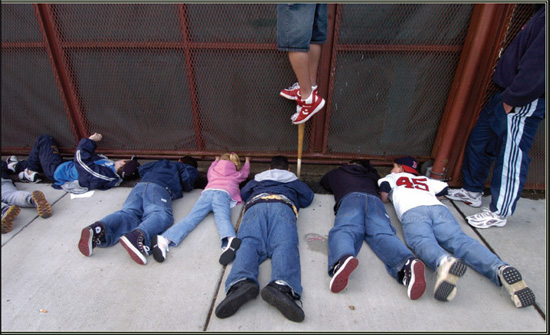
Despite losing Martinez to the Mets and Foulke to knee surgery and missing Schilling for nearly half the campaign after off-season ankle repair, the Sox remained in first place from late June until the final 10 days of September. But New York, which had been seven games under .500 in May, returned for the decisive series at Fenway a game ahead in the division.
It was God’s plan, Damon reckoned, that the two blood rivals would go head-to-head for the title. After a split of the first two games gave New York the AL East crown, Boston needed either a Sunday victory or a Cleveland loss to the White Sox to avoid a one-game Fenway playoff with the Indians for the wild-card spot. The clubhouse message board was bluntly optimistic: “TOMORROW. PACK FOR 3 DAY TRIP.”
“Our goal was to get into the postseason and our goal in the postseason is to win the World Series,” said Schilling, after Cleveland’s loss mooted his teammates’ 10-1 triumph and earned them a trip to Chicago for the divisional series. “We got Step One done.”
Step Two, though, proved a stumbling block as the White Sox, who hadn’t won a home playoff game in 46 years, claimed the first two games by counts of 14-2 (Boston’s worst October loss by run margin) and 5-4 (after trailing, 4-0) to send their scarlet counterparts home for an elimination game. “Our backs are truly against the wall,” acknowledged Epstein. “It’s the personality of this team not to do things easily.”
The White Sox finished things off with a 5-3 decision in Fenway and went on to sweep Houston to win their first World Series since 1917, ending a drought that had been a year longer than Boston’s. “No one can ever take away what we did last year,” said Kevin Millar. “This year we fought. We just weren’t the better team.”
Fans soon found out there was fighting going on behind the scenes, too. On Halloween night, Epstein walked out of Fenway wearing a gorilla suit to avoid reporters’ questions about why he’d just turned down a contract extension. When he returned (in street clothes) in January, he had a new contract and nothing but good things to say about Sox CEO Larry Lucchino.
Front-office drama aside, multiple additions and deletions were inevitable during the off-season. Pitcher Josh Beckett and third baseman Mike Lowell, who had both won rings with the Marlins, arrived in a seven-player deal. Departing free agents included Damon (to the Yankees), Mueller (Dodgers), and Millar (Orioles).

REMDAWG’S LONG RUN
In February 1988, former Boston second baseman Jerry Remy was named analyst for Red Sox games on New England Sports Network. Little did he know at the time that his tenure in front of the camera would stretch nearly three times longer than his playing career did.
Play-by-play partners have included local legend Ned Martin, Sean McDonough, Bob Kurtz, and Don Orsillo, with whom Remy has worked the past 11 seasons. Perhaps owing in part to Remy’s local roots and his clear-cut, concise game analysis, his popularity soared—he gained a nickname (“RemDawg”), a website called the Remy Report, and even a couple of restaurants that bear his name.
Remy was chosen from among five finalists in 1988 to succeed Bob Montgomery on NESN. The other candidates were also former Sox players: Dick Radatz, Rick Miller, Jim Lonborg, and Mike Andrews. Montgomery, a former Sox catcher who began as a TV analyst in 1982, continued in that role on Channel 38 through 1995.
In July 2010, Remy and NESN agreed to a multiyear contract extension. This followed a three-and-a-half-month absence from the booth during the 2009 season while he recuperated from lung cancer surgery, along with a post-surgery infection and bout with depression. Just before his return to the booth in August 2009, he said he’d received so much support from fans that he felt guilty about not coming back sooner.
“I have boxes and boxes of cards, letters, prayers, tweets, e-mails,” said Remy. “But I was crying reading them. . . . In a way, you feel like you’ve done something right for these people.” Returning to the TV booth, he realized, was the way to thank them.
Jerry Remy acknowledged the fans upon returning to the NESN broadcast booth with Don Orsillo in August 2009, following Remy’s surgery for lung cancer.
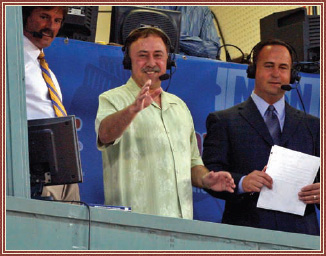
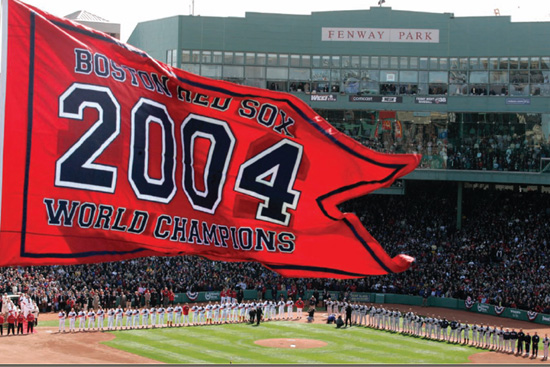
The Red Sox and Yankees lined up for the national anthem as the first Red Sox pennant in 86 years flew over Fenway Park on Opening Day 2005.
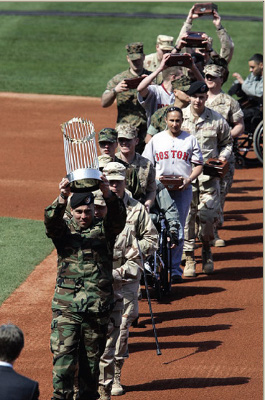
War veterans escorted the World Series trophy and rings.
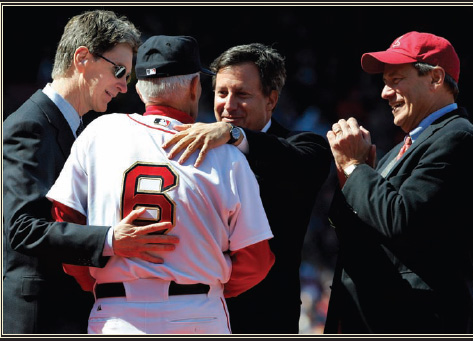
Red Sox legend Johnny Pesky (6) finally received a World Series ring, along with congratulations from team executives (left to right) John Henry, Tom Werner, and Larry Lucchino.